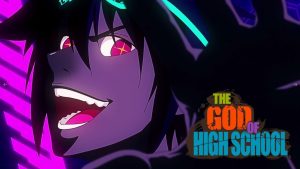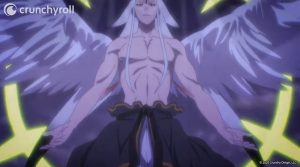Based on the hit manhwa, The God of High School is an action series like no other as you’re treated to high-octane action in just about every episode. Considering that the series takes place in Korea, it’s only natural that the anime portrays its martial arts culture, but with that pop you can only find in anime. So, what are some Korean martial arts that are portrayed in this series? Read to find out!
Taekwondo
We’re pretty sure most of you know that Taekwondo is the national sport of South Korea and is one of the most commonly practiced martial arts in the world. Prior to The God of High School, the most notable media portrayal of Taekwondo probably had to be the martial arts cult classic, The Best of the Best. In the West, Taekwondo is commonly known as “Korean Karate,” which is technically true. When Taekwondo was founded in post-World War II South Korea, Korean traditional martial arts were banned under the occupation of the Empire of Japan, and many Korean martial arts practitioners at the time mostly knew Japanese and Chinese martial arts. Choi Hong Hi, who was the General of the South Korean Army upon independence, wanted to unify martial arts for the military and with whatever the Koreans had available, they took what they knew from Chinese and Japanese martial arts and called it Taekwondo, or what you can loosely translate as “The Way of the Foot and Fist.”
Since The God of High School is Korean in origin, it’s only natural that Jin Mori, the main character, uses Taekwondo, or as he calls it, “Renewal Taekwondo.” Just like real-life Taekwondo, Renewal Taekwondo is flashy and is a kicking oriented martial art. Most of the kicks are spinning back kicks, snapping roundhouse kicks, sidekicks, and crazy jump kicks. If you look up Taekwondo demonstrations on YouTube or any video site, you’re bound to find many techniques utilized by Mori.
As portrayed in Mori’s fight against Ilpyo, Renewal Taekwondo has weaknesses that can be applied to real-life Taekwondo. It doesn’t specialize in close-range combat and many of the moves are telegraphed, which is why the art failed in the early days of MMA. Despite that, many modern MMA champions have backgrounds in Taekwondo such as former UFC middleweight champion Anderson Silva (who actually wanted to compete in Taekwondo in the Rio de Janeiro Olympics back in 2012), and former UFC lightweight champions Anthony Pettis and Ben Henderson are also accomplished Taekwondo black belts.
Taekkyon
Taekkyon, Ilpyo’s fighting style, is considered the original traditional Korean martial art. It’s often mislabeled as an ancestor of Taekwondo due to the incorrect assumptions of Syngman Rhee, the first president of South Korea, when he witnessed a martial arts exhibition. Due to the banning on martial arts during Japanese occupation, much of the documentation is very scarce and some techniques were thought to have been forgotten. Thanks to Song Duk Di, a master of Taekkyon prior to the occupation, it made a small comeback after the end of World War II. As portrayed in Ilpyo’s flashbacks, Taekkyon practitioners wear a uniform known as a dobok, which kind of resembles the gi Chozen wears in the ending fight of the second Karate Kid movie. Compared to Taekwondo, which is more for show, there is some historical evidence that Taekkyon is more for actual street combat, and ancient villagers thought of it as an art for thugs.
As seen through Ilpyo’s fight with Mori, Taekkyon uses grappling counters which are similar to San Shou. If you’ve seen Cung Le, a former MMA and San Shou champion (he actually never knew San Shou when he first competed. He was a Taedwondo black belt who was also a high school wrestler), then you get an idea of what we’re talking about. For example, the Taekkyon practitioner catches an opponent’s kick, and then immediately takes down the opponent with a trip or throw. When Ilpyo first fights Mori in the park, he does something along the lines of this, but as an anime, they exaggerate it to make it look like a modified version of the Michinoku Driver, a famous finisher in Japanese professional wrestling.
Unfortunately, what God of High School fails to portray is the unique stance of Taekkyon and its unorthodox footwork. If you’ve seen Capoeira, which is famously portrayed by Eddy Gordo in the Tekken franchise, Taekkyon’s footwork and stance is kind of similar to it. As for any real-life fighters versed in the art, former K-1 and Strikeforce champion Alistair Overeem has experimented with it.
Kyokushin Karate
Wait a minute, isn’t Kyokushin Karate, which is what Daewi practices, a Japanese martial art? Yes, Karate is traditionally Japanese, but Kyokushin, which emphasizes full-contact, was founded by Masutatsu Oyama, a native Korean whose birth name was Choi Yeong-eui. By the time Oyama founded the Kyokushin school in the late 1950s, he already had training in Chinese martial arts and obtained black belts in Shotokan and Goju-ryu Karate. While the majority of traditional Korean and Japanese martial arts tend to be long-range oriented and emphasize sticking and moving, Kyokushin focuses on close-range fighting and hardening the body.
As seen through Daewi, Kyokushin is all about power and it focuses more on hard punches that are intended to do damage. While you do see Daewi punch to the face in his fights, Kyokushin tournaments (where no protective gear is used) do not allow punches to the face because they can cause cuts and bruises, and break the fighters’ hands. Some notable real-life practitioners of Kyokushin are three-time UFC champion Georges St. Pierre, former UFC and Pancrase heavyweight champion Bas Rutten, and the legendary K-1 champion, the late Andy Hug.
Final Thoughts
Upon the drafting of this article, we have yet to see other notable Korean martial arts such as Tang Soo Do, Hapkido, and/or Subak. If you don’t know what Tang Soo Do is, it was the first style that Chuck Norris got a black belt in when he was stationed in Korea during his enlistment in the US Air Force. Going back to Kyokushin, just like how it was founded by a Korean, Tang Soo Do was founded by Hwang Kee, a Korean who got a black belt in Shotokan Karate under Ginichi Funakoshi (the founder of Shotokan), and brought it back to Korea as Tang Soo Do, a Korean way of saying Karate. Considering the impact the style has on martial arts media, we hope that it will find its anime debut through The God of High School.
While martial arts anime is known to take its action beyond our wildest imaginations, it’s still nice to see that a product of Korean origins is portraying its own unique culture. No, nobody can kick out tornados or flames (but call Dana White if you do), but it’s nice to see traditional Korean martial arts portrayed in anime regardless.
So, how do you feel about the portrayal of native Korean martial arts in The God of High School? Do you think they should stick to what is known by the mainstream such as Taekwondo? Or should we see more obscure martial arts like Subak? If you’re an enthusiast, share your thoughts!
Recommended Post
6 Anime Like The God of High School [Recommendations]
Recommended Post





